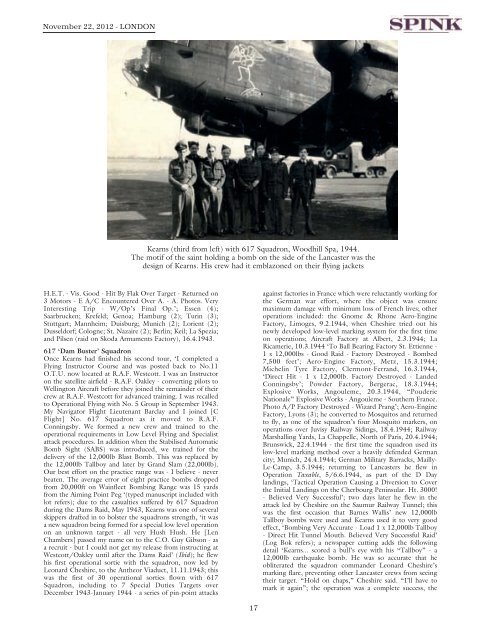orders, decorations, campaign medals and militaria - Spink
orders, decorations, campaign medals and militaria - Spink
orders, decorations, campaign medals and militaria - Spink
Create successful ePaper yourself
Turn your PDF publications into a flip-book with our unique Google optimized e-Paper software.
November 22, 2012 - LoNdoN<br />
Kearns (third from left) with 617 Squadron, Woodhill Spa, 1944.<br />
The motif of the saint holding a bomb on the side of the Lancaster was the<br />
design of Kearns. His crew had it emblazoned on their flying jackets<br />
H.E.T. - Vis. Good - Hit By Flak Over Target - Returned on<br />
3 Motors - E A/C Encountered Over A. - A. Photos. Very<br />
Interesting Trip - W/Op’s Final Op.’; Essen (4);<br />
Saarbrucken; Krefeld; Genoa; Hamburg (2); Turin (3);<br />
Stuttgart; Mannheim; Duisburg; Munich (2); Lorient (2);<br />
Dusseldorf; Cologne; St. Nazaire (2); Berlin; Keil; La Spezia;<br />
<strong>and</strong> Pilsen (raid on Skoda Armaments Factory), 16.4.1943.<br />
617 ‘Dam Buster’ Squadron<br />
Once Kearns had finished his second tour, ‘I completed a<br />
Flying Instructor Course <strong>and</strong> was posted back to No.11<br />
O.T.U. now located at R.A.F. Westcott. I was an Instructor<br />
on the satellite airfield - R.A.F. Oakley - converting pilots to<br />
Wellington Aircraft before they joined the remainder of their<br />
crew at R.A.F. Westcott for advanced training. I was recalled<br />
to Operational Flying with No. 5 Group in September 1943.<br />
My Navigator Flight Lieutenant Barclay <strong>and</strong> I joined [C<br />
Flight] No. 617 Squadron as it moved to R.A.F.<br />
Conningsby. We formed a new crew <strong>and</strong> trained to the<br />
operational requirements in Low Level Flying <strong>and</strong> Specialist<br />
attack procedures. In addition when the Stabilised Automatic<br />
Bomb Sight (SABS) was introduced, we trained for the<br />
delivery of the 12,000lb Blast Bomb. This was replaced by<br />
the 12,000lb Tallboy <strong>and</strong> later by Gr<strong>and</strong> Slam (22,000lb).<br />
Our best effort on the practice range was - I believe - never<br />
beaten. The average error of eight practice bombs dropped<br />
from 20,000ft on Wainfleet Bombing Range was 15 yards<br />
from the Aiming Point Peg ‘(typed manuscript included with<br />
lot refers); due to the casualties suffered by 617 Squadron<br />
during the Dams Raid, May 1943, Kearns was one of several<br />
skippers drafted in to bolster the squadrons strength, ‘it was<br />
a new squadron being formed for a special low level operation<br />
on an unknown target - all very Hush Hush. He [Len<br />
Chambers] passed my name on to the C.O. Guy Gibson - as<br />
a recruit - but I could not get my release from instructing at<br />
Westcott/Oakley until after the Dams Raid’ (Ibid); he flew<br />
his first operational sortie with the squadron, now led by<br />
Leonard Cheshire, to the Antheor Viaduct, 11.11.1943; this<br />
was the first of 30 operational sorties flown with 617<br />
Squadron, including to 7 Special Duties Targets over<br />
December 1943-January 1944 - a series of pin-point attacks<br />
17<br />
against factories in France which were reluctantly working for<br />
the German war effort, where the object was ensure<br />
maximum damage with minimum loss of French lives; other<br />
operations included: the Gnome & Rhone Aero-Engine<br />
Factory, Limoges, 9.2.1944, when Cheshire tried out his<br />
newly developed low-level marking system for the first time<br />
on operations; Aircraft Factory at Albert, 2.3.1944; La<br />
Ricamerie, 10.3.1944 ‘To Ball Bearing Factory St. Ettienne -<br />
1 x 12,000lbs - Good Raid - Factory Destroyed - Bombed<br />
7,500 feet’; Aero-Engine Factory, Metz, 15.3.1944;<br />
Michelin Tyre Factory, Clermont-Ferr<strong>and</strong>, 16.3.1944,<br />
‘Direct Hit - 1 x 12,000lb. Factory Destroyed - L<strong>and</strong>ed<br />
Conningsby’; Powder Factory, Bergerac, 18.3.1944;<br />
Explosive Works, Angouleme, 20.3.1944, “Pouderie<br />
Nationale” Explosive Works - Angouleme - Southern France.<br />
Photo A/P Factory Destroyed - Wizard Prang’; Aero-Engine<br />
Factory, Lyons (3); he converted to Mosquitos <strong>and</strong> returned<br />
to fly, as one of the squadron’s four Mosquito markers, on<br />
operations over Juvisy Railway Sidings, 18.4.1944; Railway<br />
Marshalling Yards, La Chappelle, North of Paris, 20.4.1944;<br />
Brunswick, 22.4.1944 - the first time the squadron used its<br />
low-level marking method over a heavily defended German<br />
city; Munich, 24.4.1944; German Military Barracks, Mailly-<br />
Le-Camp, 3.5.1944; returning to Lancasters he flew in<br />
Operation Taxable, 5/6.6.1944, as part of the D Day<br />
l<strong>and</strong>ings, ‘Tactical Operation Causing a Diversion to Cover<br />
the Initial L<strong>and</strong>ings on the Cherbourg Peninsular. Ht. 3000!<br />
- Believed Very Successful’; two days later he flew in the<br />
attack led by Cheshire on the Saumur Railway Tunnel; this<br />
was the first occasion that Barnes Wallis’ new 12,000lb<br />
Tallboy bombs were used <strong>and</strong> Kearns used it to very good<br />
effect, ‘Bombing Very Accurate - Load 1 x 12,000lb Tallboy<br />
- Direct Hit Tunnel Mouth. Believed Very Successful Raid’<br />
(Log Bok refers); a newspaper cutting adds the following<br />
detail ‘Kearns... scored a bull’s eye with his “Tallboy” - a<br />
12,000lb earthquake bomb. He was so accurate that he<br />
obliterated the squadron comm<strong>and</strong>er Leonard Cheshire’s<br />
marking flare, preventing other Lancaster crews from seeing<br />
their target. “Hold on chaps,” Cheshire said. “I’ll have to<br />
mark it again”; the operation was a complete success, the

















